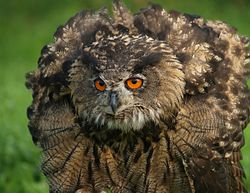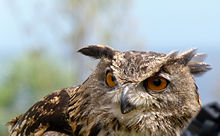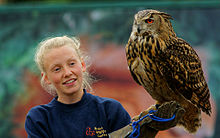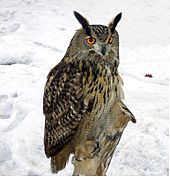
Eurasian Eagle-Owl
Did you know...
SOS Children has tried to make Wikipedia content more accessible by this schools selection. See http://www.soschildren.org/sponsor-a-child to find out about child sponsorship.
| Eurasian Eagle-Owl | |
|---|---|
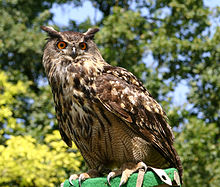 |
|
| Conservation status | |
 Least Concern ( IUCN 3.1) |
|
| Scientific classification | |
| Kingdom: | Animalia |
| Phylum: | Chordata |
| Class: | Aves |
| Order: | Strigiformes |
| Family: | Strigidae |
| Genus: | Bubo |
| Species: | B. bubo |
| Binomial name | |
| Bubo bubo (Linnaeus, 1758) |
|
 |
|
| Range of Eurasian Eagle-Owl | |
The Eurasian Eagle-Owl (Bubo bubo) is a species of eagle owl resident in much of Eurasia. It is sometimes called the European Eagle-Owl and is, in Europe where it is the only member of its genus besides the Snowy Owl (B. scandiacus), occasionally abbreviated to just Eagle-Owl. In India, it is often called the Indian Great Horned Owl, though this may cause confusion with the similarly-named American bird. It is one of the largest species of owls.
Description
The Eagle Owl is a very large and powerful bird, smaller than the Golden Eagle (Aquila chrysaetos) but larger than the Snowy Owl. It is sometimes referred to as the world's largest owl, although Blakiston's Fish Owl (B. blakistoni) is slightly heavier on average and the Great Grey Owl (Strix nebulosa) is slightly longer on average. The Eagle Owl has a wingspan of 160–188 cm (63–74 in), with the largest specimens attaining 200 cm (79 in). The total length of the species can range from 56 to 75 cm (22 to 30 in). Females weigh 1.75–4.2 kg (3.9–9.3 lb) and males weigh 1.5–3 kg (3.3–6.6 lb). In comparison, the Barn Owl (Tyto alba), the world's most widely-distributed owl species, weighs about 500 grams (1.1 lbs) and the Great Horned Owl (B. virginianus), which fills the Eagle Owl's ecological niche in North America, weighs around 1.4 kg (3.1 lbs). Among standard measurements, the tail measures 23–31 cm (9.1–12 in) long, the tarsus measures 7.4–8.8 cm (2.9–3.5 in) and the bill is 4.2–5.8 cm (1.7–2.3 in).
Based on the wing chord length (the only measurement taken for the many of the less studied subspecies), there is considerable variation across the races, with owls at higher altitudes and more Northern latitudes being the larger varieties. The smallest race is B. b. nikolskii, found in warm, rocky desert-like habitats from eastern Iraq and Iran to Pakistan and Afghanistan and measuring 37.8–46 cm (14.9–18 in) in wing chord length. The largest race is B. b. yenisseenis of the icy forests of central Siberia to northern Mongolia at 44.3–51.8 cm (17.4–20.4 in). Many subspecies still require detailed description and study. Two owls formerly considered subspecies of the Eurasian Eagle Owl are now recognized as distinct species: the Pharaoh Eagle-Owl (B. ascalaphus) and the Rock Eagle Owl (B. bengalensis).
The great size, bulky, barrel-shaped build, ear tufts and orange eyes make this a distinctive species. The ear tufts of males are more upright than those of females. The plumage coloration, across 13 accepted subspecies, however can be somewhat variable. The upperparts may brown-black to tawny-buff to pale creamy gray, typically showing as dense freckling on the forehead and crown, stripes on the nape, sides and back of the neck, and dark splotches on the pale ground colour of the back, mantle and scapulars. A narrow buff band, freckled with brown or buff, often runs up from the base of the bill, above the inner part of the eye and along the inner edge of the black-brown ear tufts. The rump and upper tail-coverts are delicately patterned with dark vermiculations and fine wavy barring. The facial disc is tawny-buff, speckled with black-brown, so densely on the outer edge of the disc as to form a "frame" around the face. The chin and throat are white continuing down the centre of the upper breast. The whole of the underparts except for chin, throat and centre of upper breast is covered with fine dark wavy barring, on a tawny-buff ground colour. Legs and feet (which are feathered almost to the talons) are likewise marked on a buff ground colour but more faintly. The tail is tawny-buff, mottled dark grey-brown with about six black-brown bars. The bill and feet are black, the iris is orange (yellow in some subspecies).
Habitat
Eagle Owls are distributed sparsely through rocky areas but can potentially inhabit a wide range of habitats. They have been found in habitats as diverse as Northern coniferous forests and the edge of vast deserts. They are often found in the largest numbers in areas where cliffs and ravines are surrounded by a scattering of trees and bushes. Taiga, rocky coast lines, steppe and grasslands, may also be visited, largely while hunting in their large territories. Due to their preference for rocky areas, the species is often found in mountainous areas and can be found up to elevations of 2,000 m (6,600 ft) in Europe and 4,500 m (14,800 ft) in Asia. However, they can also be found at sea level.
Although found in the largest numbers in areas sparsely populated by humans, farmland is sometimes inhabited and they even have been observed living in park-like settings within European cities. Since 2005, at least five couples have nested in Helsinki. This is due in part to feral European rabbits (Oryctolagus cuniculus) having recently populated the Helsinki area, originally from pet rabbits released to the wild. The number is expected to increase due to the growth of the European rabbit population in Helsinki. European Hares (Lepus europaeus), the often preferred prey species of the Eagle-owls in their natural habitat, live only in rural areas of Finland, not in the city centre. In June 2007, an Eagle Owl nicknamed 'Bubi' landed in the crowded Helsinki Olympic Stadium during the European Football Championship qualification match between Finland and Belgium. The match was interrupted for six minutes. After tiring of the match, following Jonathan Johansson's opening goal for Finland, the bird left the scene. Finland's national football team have had the nickname Huuhkajat (Finnish for Eurasian Eagle-Owls) ever since. The owl was named "Helsinki Citizen of the Year" in December 2007.
Behaviour
The Eurasian Eagle Owl is largely nocturnal in activity, as are most owl species. The call of the Eagle Owl is a deep resonant ooh-hu with emphasis on the first syllable for the male, and a more high-pitched uh-Hu for the female. Each member of an Eagle Owl population can be identified by means of its vocalizations.
This broad-winged species has a strong direct flight, usually consisting of shallow wing beats and long, fast glides. It has, unusually for an owl, also been known to soar on updrafts on a few occasions. The latter method of flight has led them to be mistaken for Buteos, which are smaller and quite differently-proportioned.
Feeding
This eagle owl mainly feeds on small mammals in the 200–2,000 g (0.44–4.4 lb) weight range, such as voles, rats, mice, rabbits and hares. However, prey can be killed up to the size of both fully-grown foxes and marmots and young deer (up to a mass of 17 kg (37 lb)), if taken by surprise. In central Europe, hedgehogs are often a favorite prey item, being eaten after the owl skins off their prickily backs. Eagle owls may habitually visit refuse dumps to predate rats. The other significant group of prey for Eurasian Eagle Owls is other birds and almost any type of bird is potential prey. Common avian prey includes corvids, grouse, woodpeckers, herons and, especially near coastal areas, ducks, seabirds and geese. Other raptors, including large species such as Northern Goshawks (Accipiter gentilis), Peregrine Falcons (Falco peregrinus) and the largest buzzards, are regularly predated as well as almost any other type of owl encountered. When there is an opportunity, they will also prey on reptiles, including large and venomous snakes, frogs, fish and even large insects and earthworms.
Hunting usually consist of the owl watching from a perch for prey activity and then swooping down swiftly once prey is spotted. The prey is often killed quickly by the eagle owl's powerful talons though is sometimes bitten on the head to be killed as well. Then the prey item is carried off to be swallowed whole or torn into pieces with the bill. Occasionally, they may capture other birds on the wing, including nocturnal migrants which are intercepted in mid-flight. Larger prey (over 3.5 kg (7.7 lb)) is consumed on the ground which leaves the owl vulnerable to loss of their prey or even predation by predators such as foxes. The dietary preferences of the species frequently overlap with the larger Golden Eagle but direct competition is uncommon due to differing times of activity between the species.
Breeding
This species usually nests on cliff ledges, crevices and caves. Occasionally, they may also take over a bird nest made by a large bird such as common raven (Corvus corax) or golden eagle. Laying generally begins in late winter, sometimes later. One clutch per year of 1-6 white eggs are laid, measuring 56-73mm x 44.2- 53mm (2.2- 2.9" x 1.7- 2.1") and weighing 75- 80 g (2.6- 2.8 oz). They are normally laid at 3 days intervals and are incubated by the female alone, starting from the first egg, for 31–36 days. During this time, she is fed at the nest by her mate.
Once hatched, the young open their eyes at around 2 days old and are brooded for about 2 weeks. The female stays with her offspring at the nest for 4–5 weeks. For the first 2–3 weeks the male brings food to the nest or deposits it nearby, and the female feeds small pieces the young, or the male feeds the young directly. At 3 weeks the chicks start to feed themselves and begin to swallow smaller items whole. At 5 weeks the young walk around the nesting area, and at 52 days are able to fly a few metres. They may leave ground nests as early as 22–25 days old, while elevated nests are left at an age of 5–7 weeks. Fledged young are cared for by both parents for around 20–24 weeks. They become independent between September and November in Europe, and leave the parents' territory (or are driven out by them). At this time the male begins to sing again and inspect potential future nesting sites. The young technically reach sexual maturity by the following year, but do not normally breed until they can establish a territory at around 2–3 years old.
The Eagle Owl can live for up to 20 years in the wild. However, like many other bird species in captivity they can live much longer without having to endure difficult natural conditions, and have possibly survived up to 60 years in zoo collections. Healthy adults normally have no natural predators and are thus considered apex predators. The leading causes of death for this species are man-made: electrocution, traffic accidents and shooting sometimes claim the eagle owl.
Subspecies
- B. b. bubo
- B. b. hispanus
- B. b. ruthenus
- B. b. interpositus
- B. b. sibericus
- B. b. yenisseensis
- B. b. jakutensis
- B. b. ussuriensis
- B. b. turcomanus
- B. b. omissus
- B. b. nikolskii
- B. b. hemachalana
- B. b. kiautschensis
- B. b. swinhoei
